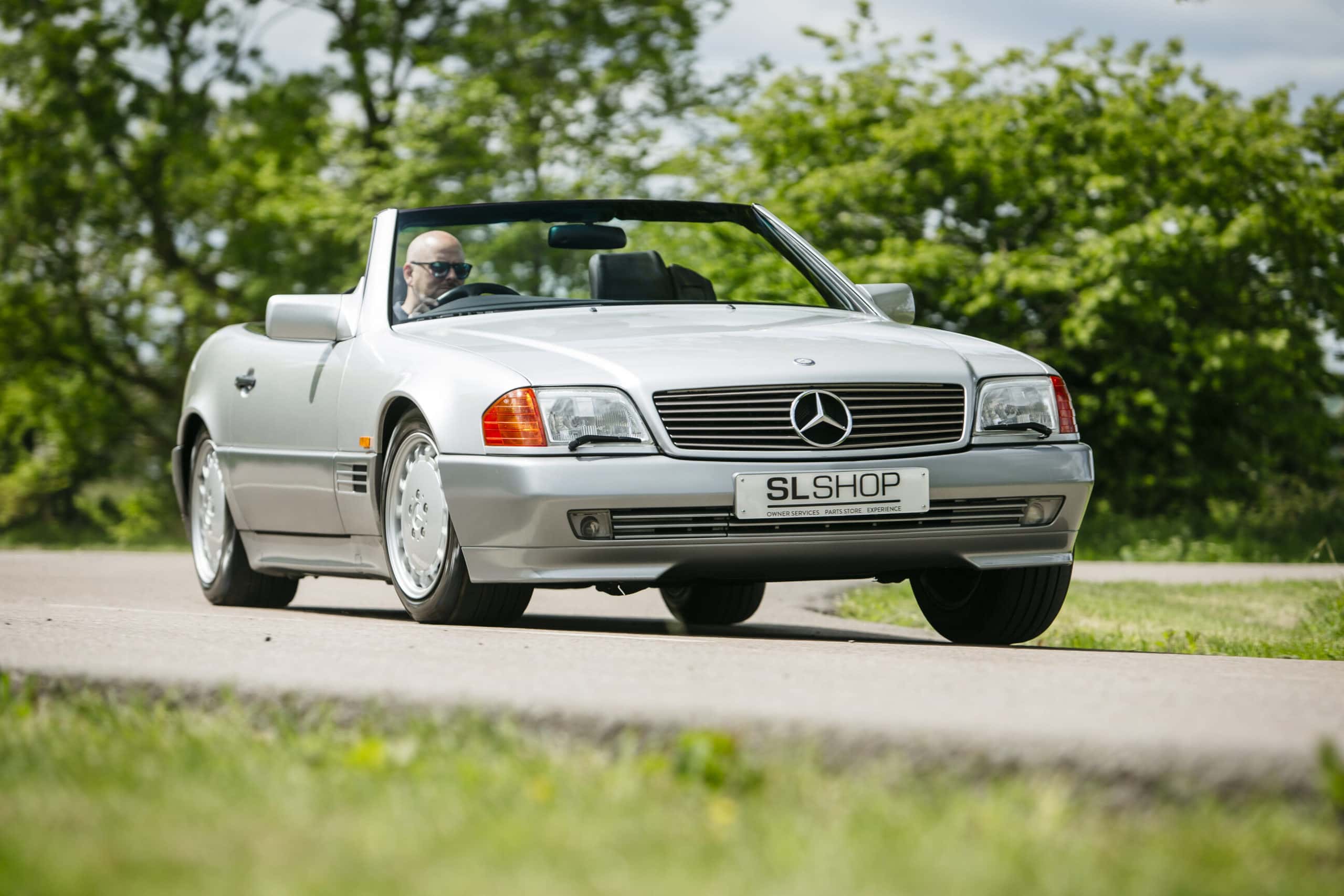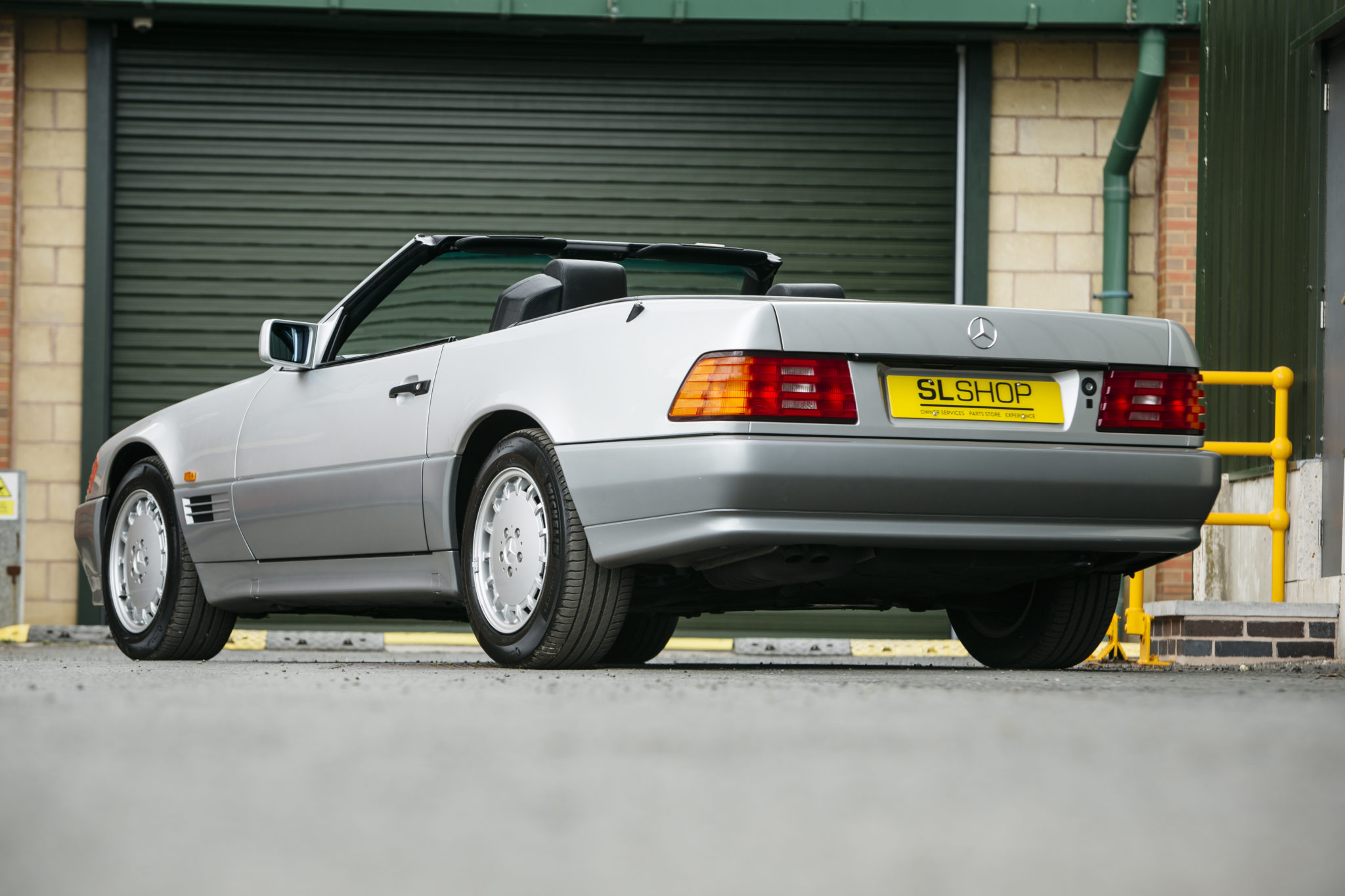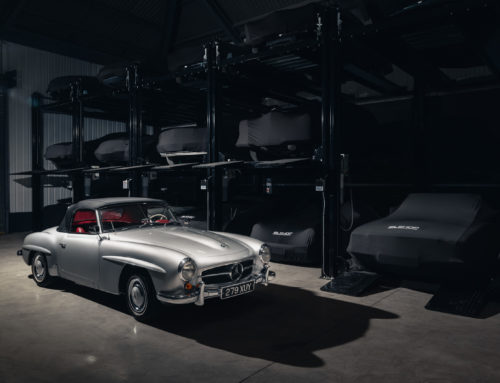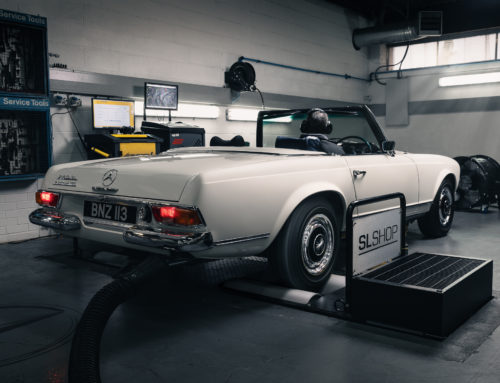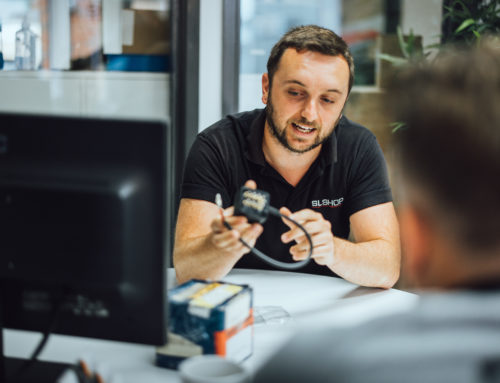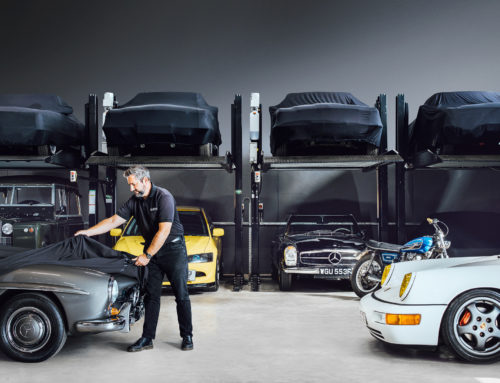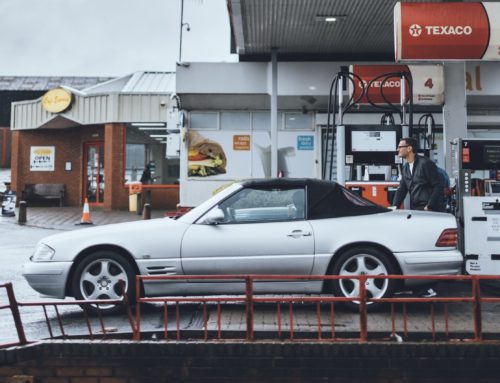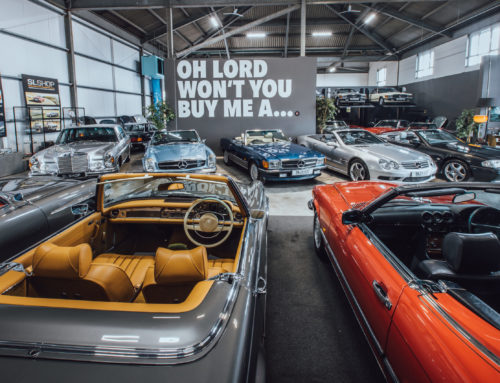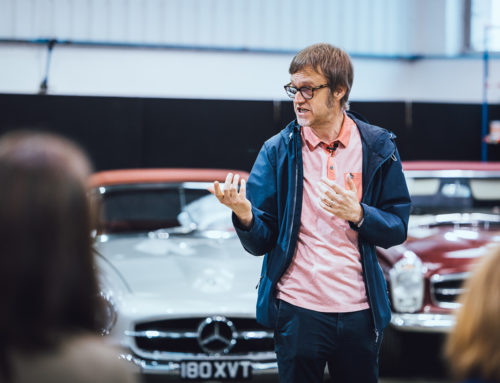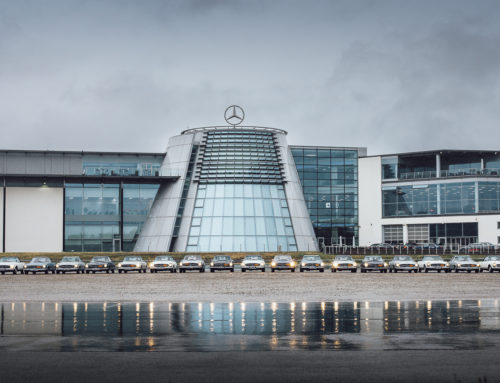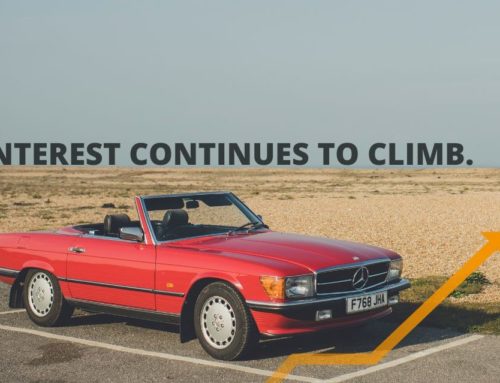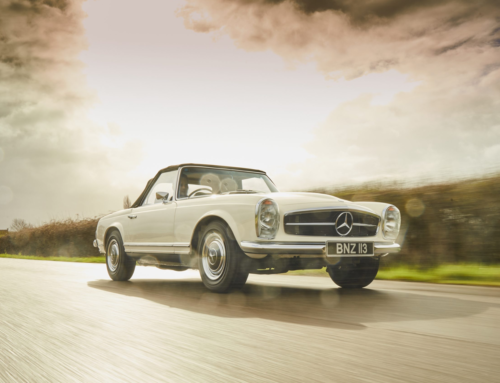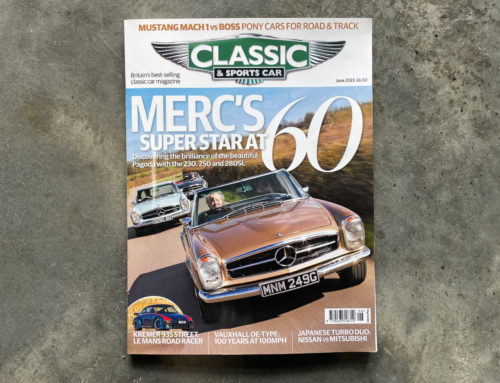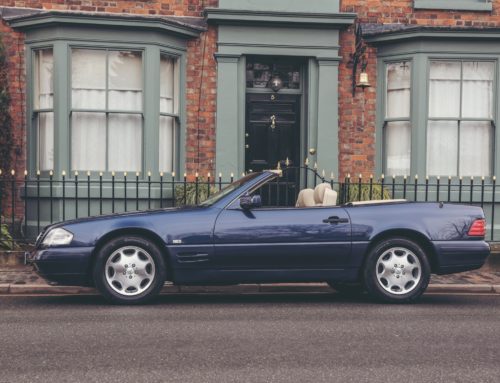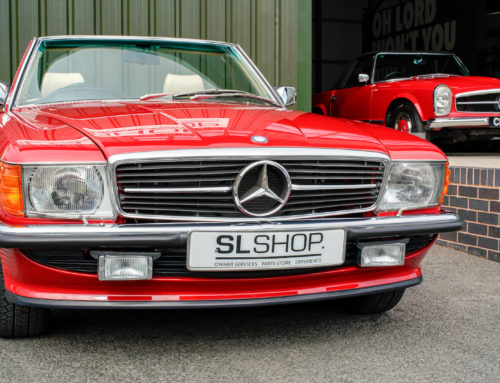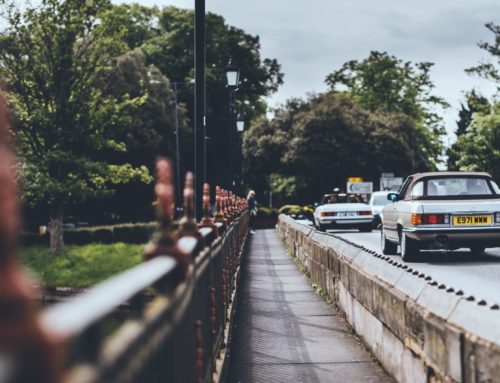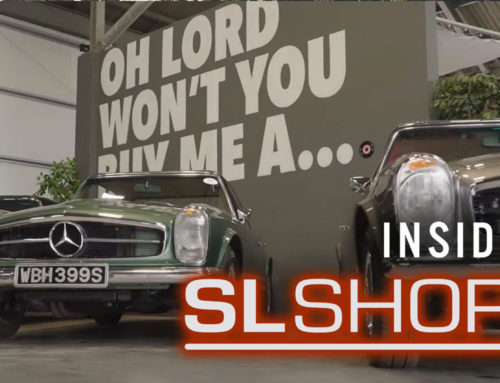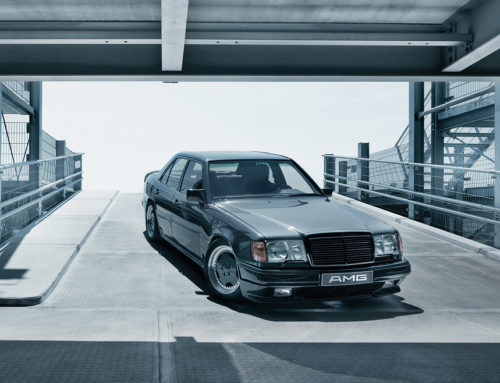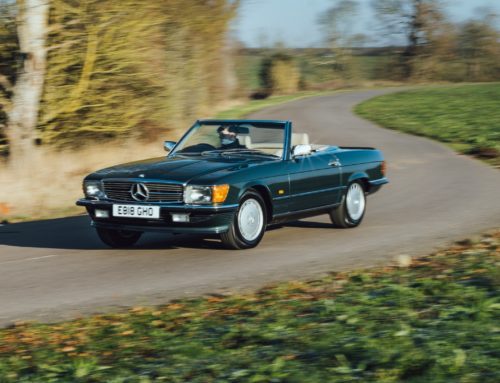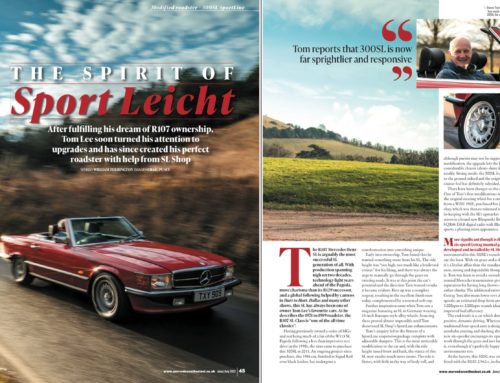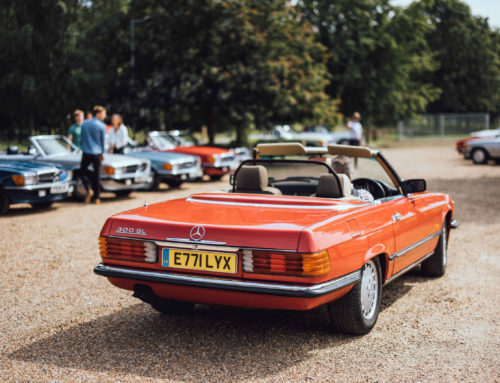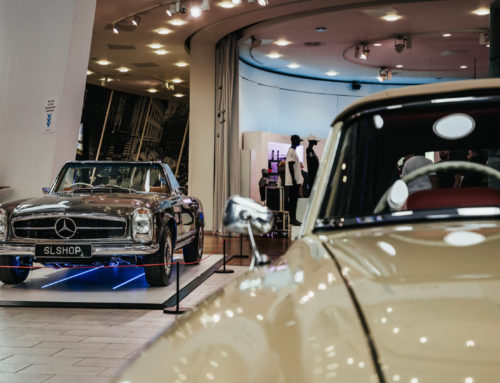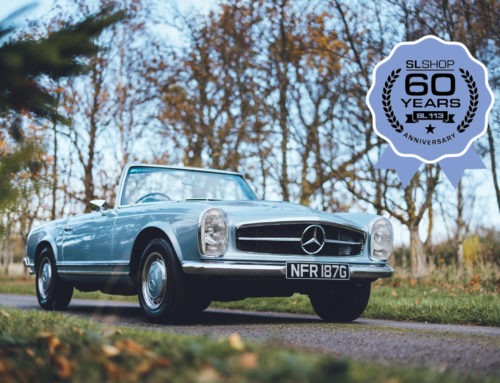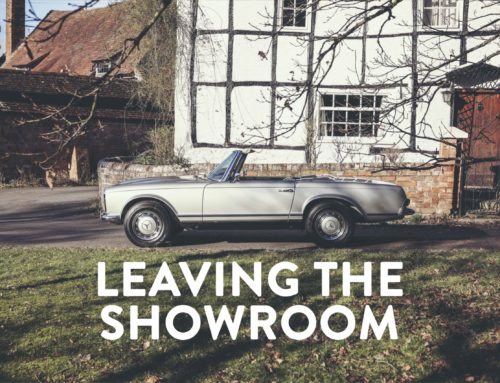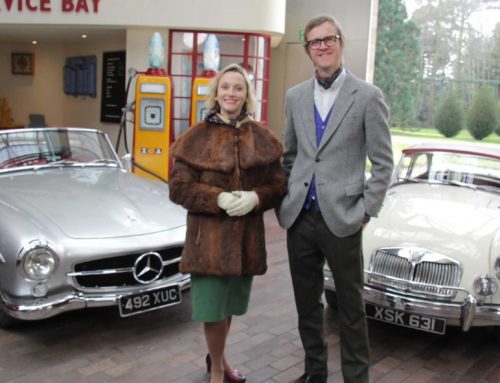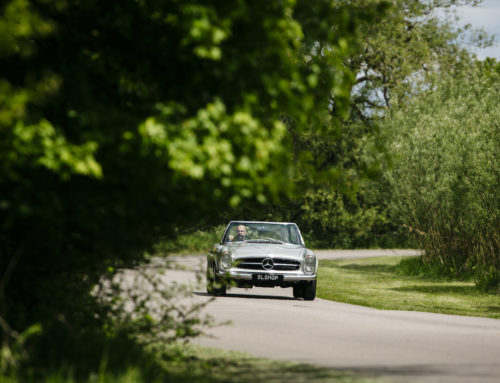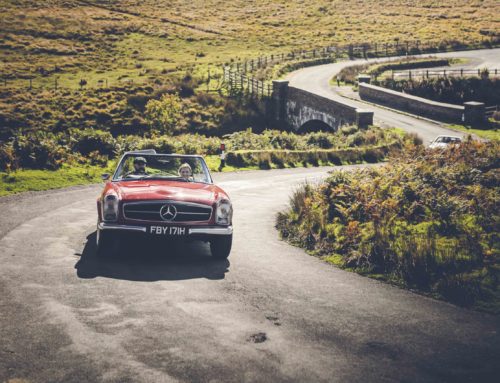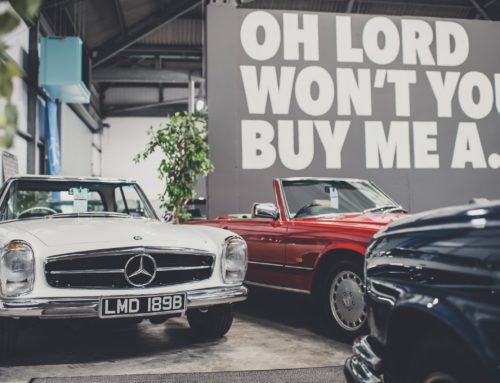You really don’t need to be a clairvoyant to see that the 1990s SL has the potential to increase in value. After all, older generations of the Mercedes-Benz ‘Sportlich-Leicht’ drop-tops have all risen sharply in the last few decades. That surely makes the Mercedes R129 – to give it its factory designation – as close to a safe bet as it gets with a classic car, right? Well, as ever in life, things are a little more complicated than that. So, before we explore the rewards of owning a Mercedes R129 – both fiscal and spiritual – we need to take an excursion back to where it all began…
Designing the Mercedes R129
Building upon – or even just replicating – the runaway success of the R107 SL must have seemed pretty daunting. Its near 18-year production span had seen it constantly evolve, keeping it cutting edge and innovative. Thankfully for Mercedes-Benz, however, the team behind the R129 would prove to be nothing short of extraordinary. The stark, some would say brutal, simplicity of the Mercedes R129’s body design was overseen by Bruno Sacco, with engineering approval granted by Johann Tomforde.
The shape of this new SL was greenlit in 1984 and with its approval came the physical embodiment of Sacco’s clinical design aesthetic. In fact, the famous designer would later pronounce this SL as his ‘most perfect car’; quite the admission from the man responsible for an entire Mercedes-Benz dynasty. Sacco’s work for Mercedes-Benz stretched back to the early 1970s C111 concept supercar but it was his pivotal design for the W126 S-Class that really changed the direction of Mercedes-Benz design forever. He would further define and perfect his elegant theme with the game-changing W201 190 and W124 E-Class. But the SL is seen by many, including the great man, as his crowning achievement.
It wasn’t simply good looks that delineated this new generation of SL, technological boundaries were pushed too. As it was developing behind the scenes at Mercedes-Benz, the world was gripped by the boom in computer technology that arrived in the early to mid-1980s. As a result, computer-assisted marvels such as electronically-controlled ignition, electronically-adjustable adaptive dampers, traction control and airbags would all eventually feature in the Mercedes R129. This SL was to be a bold statement to the world of what an affluent Mercedes-Benz could achieve and it certainly didn’t disappoint.
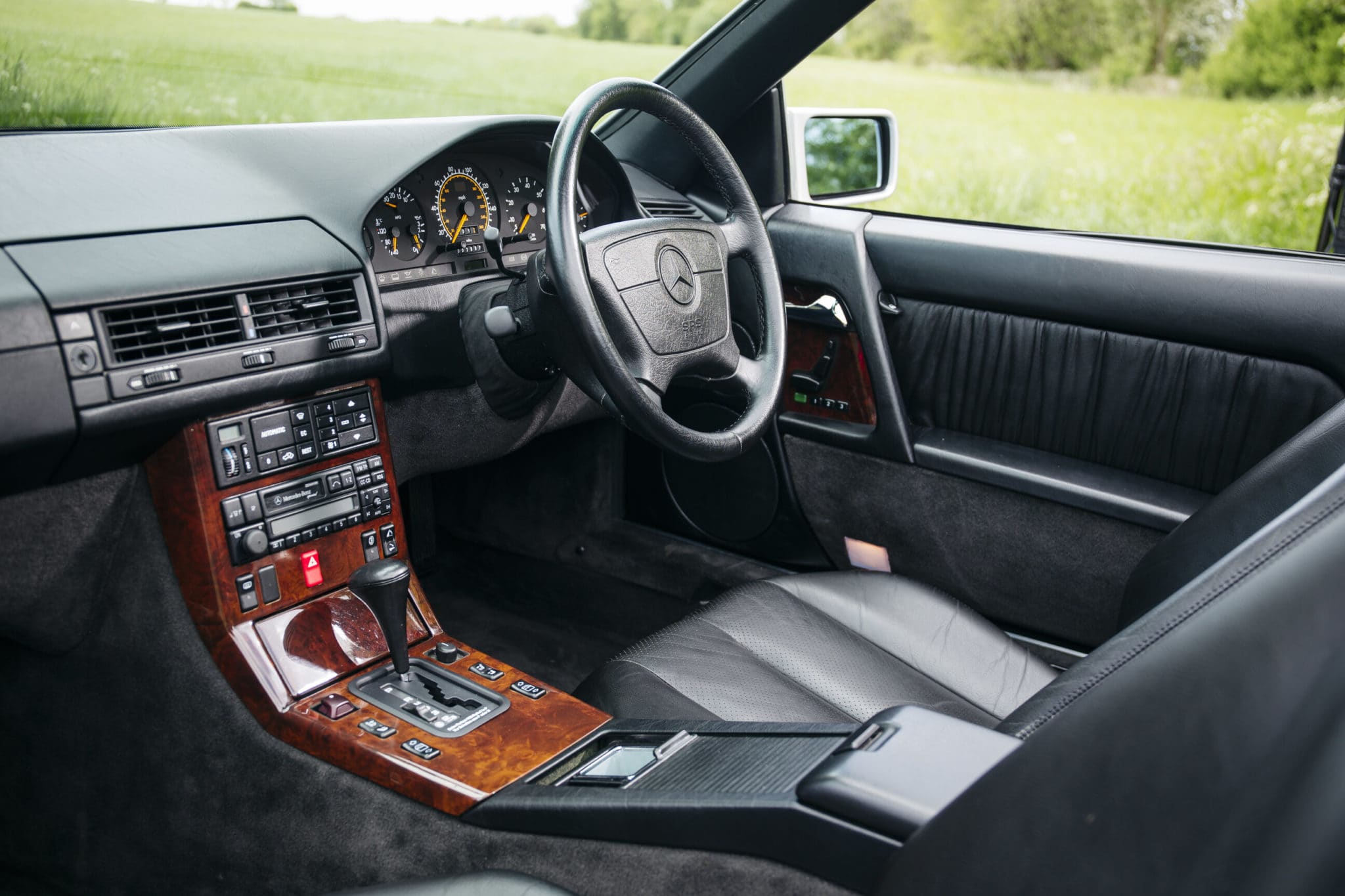
Smart and Safe technology for all owners
For many the party piece in the raft of new innovations developed for the R129 was its electro-hydraulic folding soft-top roof. Alleged to have cost £8.15-million to develop (nearly £19 million today), it was nothing short of a revelation in 1989. The task of putting the roof up when the weather turned inclement had, up to this point, been a source of amusement for the general motorist. It was frankly a pain for most open-top sports car owners. The simple pleasure of avoiding the scramble to get the tonneau open or faffing with clips was profound. At the push of a button the R129’s roof could be erected in under 20 seconds. We take this level of automation for granted today, but thirty years ago, this innovation really did change open-top motoring.
Cutting-edge tech has only been one of many Mercedes-Benz cornerstones. Another was safety. The R129 raised the bar (quite literally) in this field too. A pre-loaded spring absorber was attached to a discreetly hidden foam-covered steel hoop, placed within the rear deck. Developed by engineer Karl-Heinz Baumann, this bar could be (slowly) manually extended via a button or, more importantly would automatically (rapidly) deploy under certain conditions. Sensors detected when the car was in the process of an un-recoverable roll. If it tilted to 26 degrees with one side of the suspension at maximum rebound, the bar shot up over the rear seats in an astonishing three tenths of a second. In crash tests, with the bar deployed, the R129 not only managed to beat American safety standards for an open-top car of the time, it aced the same test for a saloon.
Not satisfied with this major innovation alone, engineers at Sindelfingen’s research and development division devised an entirely new seat design for the R129. A new integral frame made from magnesium alloy would not only increase the car’s overall torsional rigidity, but would also house a belt pretensioner, height adjuster and retractor. The seat also carried all of the motors for its position adjustment, including the height of the head restraint. So innovative was its design, plus its ability to withstand many times the forces needed in a crash, that 20 separate patents were filled to protect its design. Key engineers involved were honoured, once the car was launched, with the Paul Pietsch Award for safety.
Reassuringly Expensive
All this innovation wouldn’t come cheap of course. The R129 SL was head and shoulders above its competition in many ways in 1989, but so was its price. The top of the range 500SL retailed in the UK in December 1989 for £58,045 – that’s nearly £150k today. Or in other words £17k more than its closest rival the open-top V12 Jaguar XJS.
Not that this high entry price put customers off. For many it actually added to the SL’s appeal. Princess Di was clearly a fan, as she famously swapped her Jaguar for the new 500SL – much to the annoyance of the British tabloid press. Its bullish pricing made as much of a statement of Mercedes-Benz intent as the car’s architecture and technology. This SL was made to tempt supercar owners out of their Porsches and Ferraris… and it worked. Stuttgart would shift 204,940 of them in 12 years, the majority of which (79,827) were 500SLs.
The R129 would be powered by a myriad of six-, eight- and even 12-cylinder engines, with all but the earliest six-cylinder motors featuring dual-overhead cams and cylinder heads with variable-valve timing. In 1993 the new multi-valve M104 straight-six engine replaced the old single-cam M103 and came in either 2.8-litre or 3.2-litre displacement. These new sizes came with a corresponding change in nomenclature – the first in nearly 50 years – the SL model was now placed in front of the engine size (SL280, SL320 etc.). These next generation engines not only greatly increased horsepower – together with clever redesigns of the combustion chamber – they were also more fuel efficient. Though without a doubt, the engine that really grabbed the headlines was the all-new V12.
BMW had shocked Mercedes-Benz in 1987 with the release of its new 12-cylinder engine powering its flagship 750il. Rather than be outdone by these Bavarian upstarts, Mercedes-Benz developed its own 12-cylinder motor. The resulting 6.0-litre 389bhp M120 engine was heralded as one of the finest mills ever to grace a Mercedes-Benz engine bay. Impressive in factory tune without doubt, but once AMG got its hands on it, automotive alchemy took place. More on that a little later…
Despite a production life that was two-thirds the length of its predecessor, the R129 nevertheless received two facelifts and even more engines than the R107. The first styling revision in 1995 changed the two-tone ‘Sacco’ panel finish to a satin body shade. The ‘gill’ vents behind the front wheels went from three-slat to two and their shape was elongated. Amber indicator lens plastic became clear. Despite being a highly-effective update, there’s something aesthetically pleasing about the early cars, despite this the market prefers later examples. A final revision in 1998 saw more sculpted and sporting front and rear bumpers and side skirts. Two new engines were added, still six-cylinders but now arranged in a Vee.
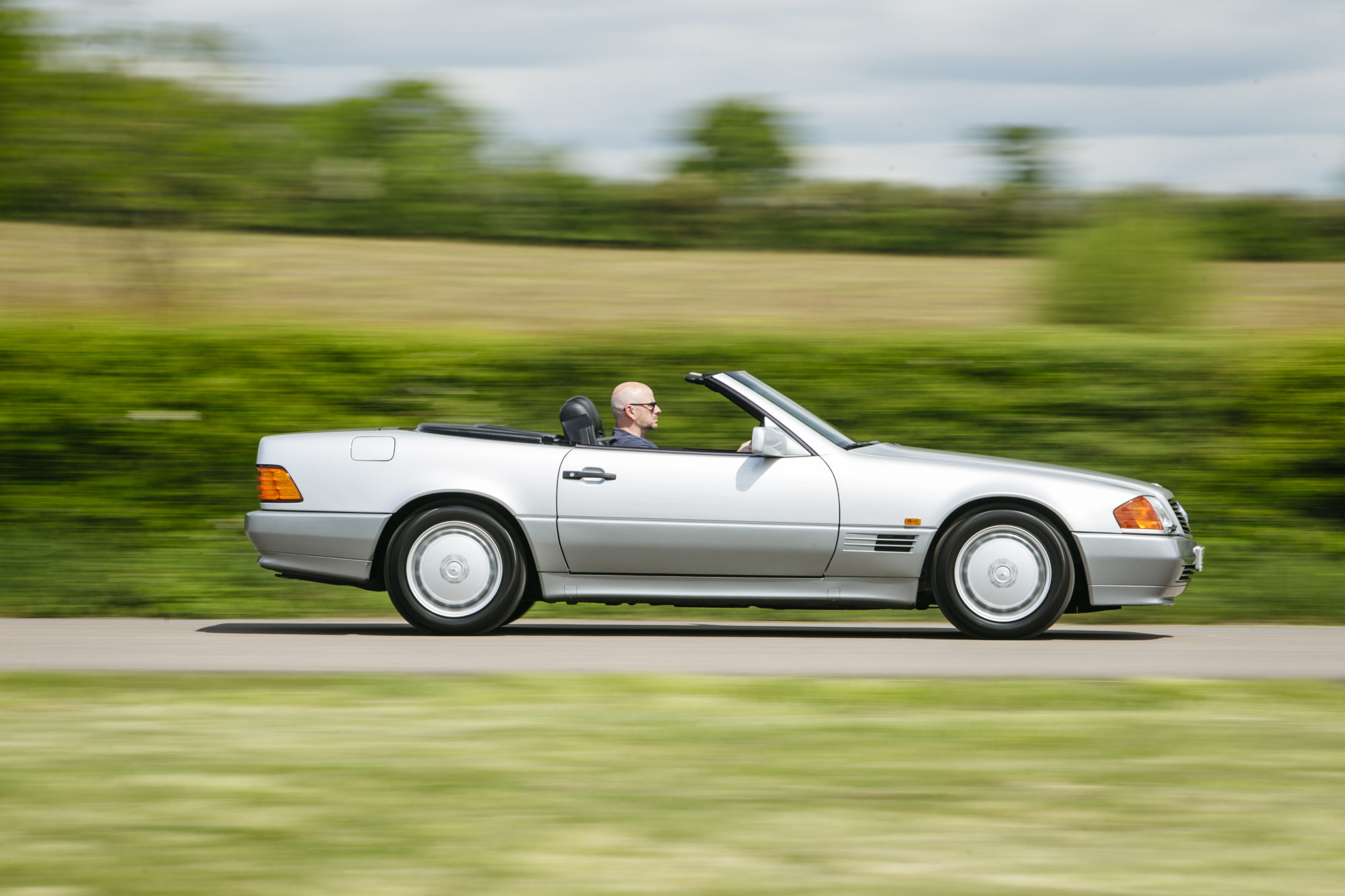
The AMG connection found its home with the Mercedes R129
Former freelance tinkerers AMG were officially folded into the Mercedes-Benz corporate family in 1999; though the two companies had been co-operating closely since the late 1960s. An agreement signed in 1990 brought AMG considerably closer to Mercedes-Benz and with its new co-operation deal in hand, the first job for Affalterbach’s finest was pepping-up the Mercedes R129. The SL60 of 1993 was its first effort, and what an effort it was…
Just 633 of these uber SLs were created; with just 49 made in right-hand drive. Mercedes-Benz, keen to maintain its cache of selling the model with the highest horsepower (in this case its V12-powered S600 and SL600) ordered AMG to limit the SL60’s output. Not exactly famed for reigning things in, AMG ignored this and though officially declared the M119 V8 in the SL60 made 375bhp, it later let leak that the real power figure was actually closer to 405bhp.
Though even this wasn’t deemed enough with AMG taking things a whole lot further when they were given the M120 V12 to tinker with. Its work on this mighty powerplant would be nothing short of breath-taking. A handbuilt 7.3-litre AMG-massaged V12 was dropped into the ultimate Mercedes R129 in 1995 to create the SL73. Its 518bhp and crank-snapping 750nm of torque propelled this autobahn cruise missile to 60mph in 4.8 seconds. De-restricted by AMG boffins it could top 200mph. A quality not lost on Italian supercar start-up firm Pagani, who closed a deal with Mercedes-Benz/AMG to supply the engine for its new Zonda hyper car.
Problems with the Mercedes R129
Furnished with all of these facts you might already be wondering why prices of Mercedes R129s haven’t already climbed into the stratosphere. Quite simply these were very expensive and complicated cars when new and just because they’re now second hand, that level of care has to be maintained. Therefore, it’s best practice to have any R129 inspected or maintained by a specialist who knows them inside; like our team here at the SL Shop. We have serviced, repaired and restored 100s of examples and know the level of care and attention that goes into keeping these magnificent machines at their best. However, plenty haven’t been so lucky, and what follows is what tends to go wrong when an R129 doesn’t receive the level of care its due.
Mention early-1990s Mercedes-Benz to any internet ‘expert’ and they’ll no doubt blurt out ‘biodegradable engine wiring’. While it’s true that this was the era of wonky insulation, the problem is nowhere near as bad as the grapevine suggests. The issue comes down to a material used for the insulation of 1991-1997 engine looms. It was actually used throughout the wiring of all models in this era but when exposed to consistent heat (in the engine bay) the material becomes brittle and cracks – leading to wiring shorts. The affected engines are those that used LH-Jetronic injection, though most SLs kept with CIS so are actually far less affected than some. It is a well-known issue however and should be inspected by an expert such as the SL Shop’s technicians, though if the worst should be discovered, replacement looms are available.
That revolutionary new powered hood is another area for occasional complaint. Whether it’s failing to move or staying either locked up or down (or somewhere in between) the hydraulic and electric systems governing smooth-hood operation need to be working in perfect sequence. The process of diagnosing what’s actually failed can be time-consuming if you’re not familiar with the mechanism. Our expert technicians have seen so many they’ll get to the heart of it in no time; saving you money and potential head-scratching.
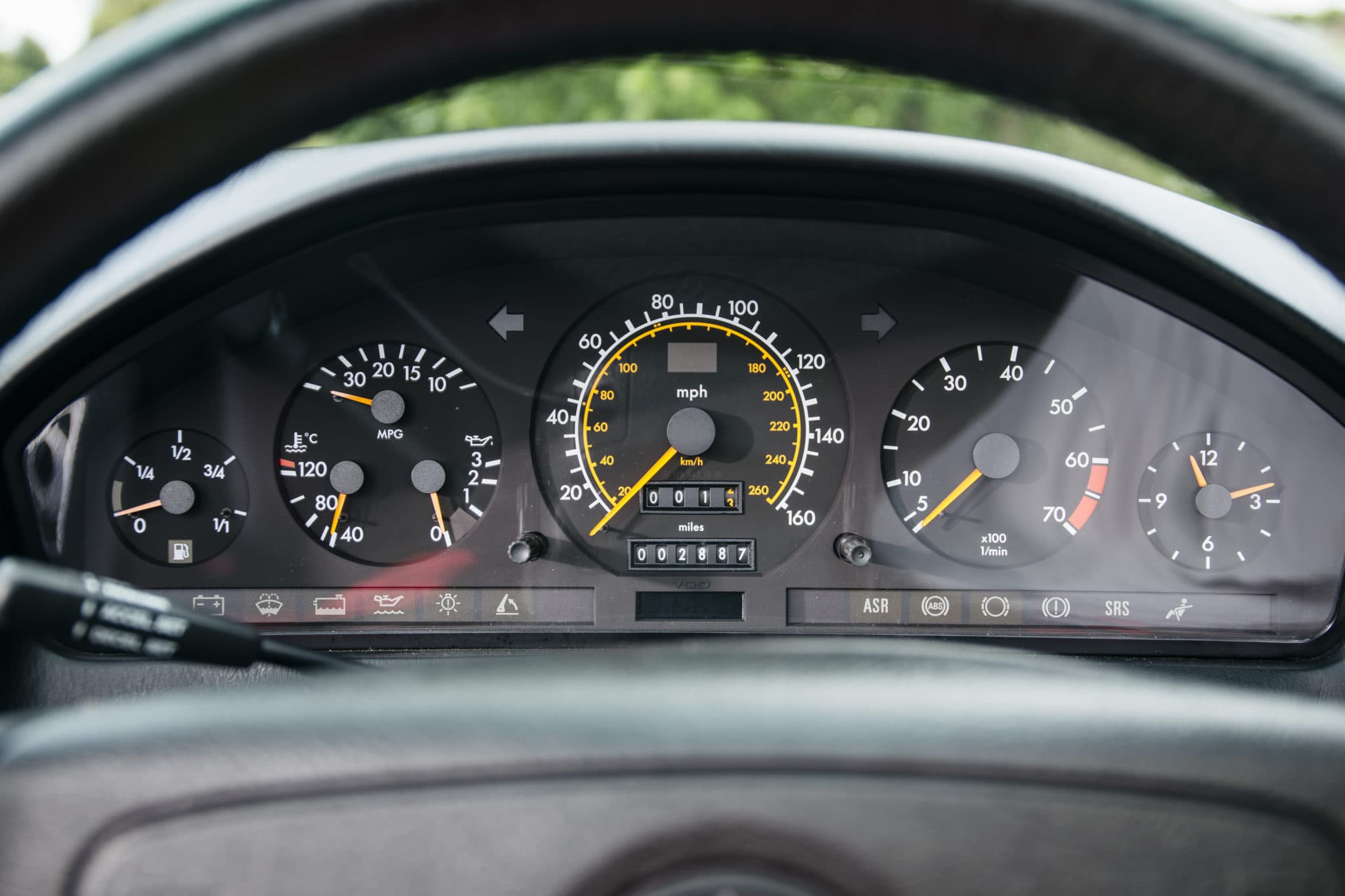
Should you buy an R129?
It might sound contrived, especially considering the outlet you’re reading this on, but now really is the time to buy an Mercedes R129. The majority of the truly unloved examples now encapsulate baked beans on Tesco shelves up and down the country. Good but higher mileage cars are now leaving their long-term elderly owners and the best enthusiast-owned cars can still be had for reasonable sums.
Recognition and acceptance from the wider classic car market for this generation is increasing day-by-day. Modern classics in general are going from strength-to-strength as a younger generation wants to put a piece of motoring royalty from their youth in the garage. Though fear not, there’s still time to get in on the R129 before every man and his dog does – but this won’t be the case for too much longer.
Values in the US (always a good gauge of trends worldwide) have risen by nearly 50% in the past five years, with major outlets such as Hagerty and Car & Driver predicting similar movement over there in the next five years. There have been some truly exceptional, delivery mileage R129s selling for six-figure sums. The SL600 and AMG versions are unsurprisingly leading the charge.
It’s a similar story over here, though the prices are perhaps a bit more confusing in their diversity. You can, for example, still find Mercedes R129s advertised for way under £10k – though there are plenty of reasons why they’re usually this ‘cheap’. Though tempting at first, they’re often earlier cars with higher miles and less desirable options and/or engines and little to no history. That’s not to say that everything in this price bracket will be one MoT-short of the scrap yard but extreme care and a thorough inspection (ideally by a marque expert) should be considered a minimum requirement.
Many a scary tale of expensive R129 failures have artificially kept prices low for a long time, which in itself has led to further problems. When any premium car drops to the bottom of its depreciation curve, it tends to be picked up by owners without the means to correctly maintain them. These were high-five and even six-figure cars when they were new and as a result, they can’t be run on a shoestring.
That’s not to say that a properly maintained example needs to cost a fortune. A sensible budget set aside to maintain and repair any of the silly things that will inevitably go wrong is all that’s required. The good news is that many of the cars that have been run into the ground have now been scrapped. The remaining pool of R129s now contains a far higher percentage of well-cared for examples, the kind of cars we track down for you at the SLShop. So, there’s no need to fear the R129 any longer. With the correct care these cars are reliable, extraordinarily comfortable and eye-wateringly fast. If you just want the looks and comfort then the basic six-cylinder cars offer much of the same with considerably reduced costs. Factor in that your Mercedes R129 is likely to appreciate in value and it might even offer free motoring for many happy years to come.
Explore our current stock of Mercedes R129 examples.
You really don’t need to be a clairvoyant to see that the 1990s SL has the potential to increase in value. After all, older generations of the Mercedes-Benz ‘Sportlich-Leicht’ drop-tops have all risen sharply in the last few decades. That surely makes the Mercedes R129 – to give it its factory designation – as close to a safe bet as it gets with a classic car, right? Well, as ever in life, things are a little more complicated than that. So, before we explore the rewards of owning a Mercedes R129 – both fiscal and spiritual – we need to take an excursion back to where it all began…
Designing the Mercedes R129
Building upon – or even just replicating – the runaway success of the R107 SL must have seemed pretty daunting. Its near 18-year production span had seen it constantly evolve, keeping it cutting edge and innovative. Thankfully for Mercedes-Benz, however, the team behind the R129 would prove to be nothing short of extraordinary. The stark, some would say brutal, simplicity of the Mercedes R129’s body design was overseen by Bruno Sacco, with engineering approval granted by Johann Tomforde.
The shape of this new SL was greenlit in 1984 and with its approval came the physical embodiment of Sacco’s clinical design aesthetic. In fact, the famous designer would later pronounce this SL as his ‘most perfect car’; quite the admission from the man responsible for an entire Mercedes-Benz dynasty. Sacco’s work for Mercedes-Benz stretched back to the early 1970s C111 concept supercar but it was his pivotal design for the W126 S-Class that really changed the direction of Mercedes-Benz design forever. He would further define and perfect his elegant theme with the game-changing W201 190 and W124 E-Class. But the SL is seen by many, including the great man, as his crowning achievement.
It wasn’t simply good looks that delineated this new generation of SL, technological boundaries were pushed too. As it was developing behind the scenes at Mercedes-Benz, the world was gripped by the boom in computer technology that arrived in the early to mid-1980s. As a result, computer-assisted marvels such as electronically-controlled ignition, electronically-adjustable adaptive dampers, traction control and airbags would all eventually feature in the Mercedes R129. This SL was to be a bold statement to the world of what an affluent Mercedes-Benz could achieve and it certainly didn’t disappoint.

Smart and Safe technology for all owners
For many the party piece in the raft of new innovations developed for the R129 was its electro-hydraulic folding soft-top roof. Alleged to have cost £8.15-million to develop (nearly £19 million today), it was nothing short of a revelation in 1989. The task of putting the roof up when the weather turned inclement had, up to this point, been a source of amusement for the general motorist. It was frankly a pain for most open-top sports car owners. The simple pleasure of avoiding the scramble to get the tonneau open or faffing with clips was profound. At the push of a button the R129’s roof could be erected in under 20 seconds. We take this level of automation for granted today, but thirty years ago, this innovation really did change open-top motoring.
Cutting-edge tech has only been one of many Mercedes-Benz cornerstones. Another was safety. The R129 raised the bar (quite literally) in this field too. A pre-loaded spring absorber was attached to a discreetly hidden foam-covered steel hoop, placed within the rear deck. Developed by engineer Karl-Heinz Baumann, this bar could be (slowly) manually extended via a button or, more importantly would automatically (rapidly) deploy under certain conditions. Sensors detected when the car was in the process of an un-recoverable roll. If it tilted to 26 degrees with one side of the suspension at maximum rebound, the bar shot up over the rear seats in an astonishing three tenths of a second. In crash tests, with the bar deployed, the R129 not only managed to beat American safety standards for an open-top car of the time, it aced the same test for a saloon.
Not satisfied with this major innovation alone, engineers at Sindelfingen’s research and development division devised an entirely new seat design for the R129. A new integral frame made from magnesium alloy would not only increase the car’s overall torsional rigidity, but would also house a belt pretensioner, height adjuster and retractor. The seat also carried all of the motors for its position adjustment, including the height of the head restraint. So innovative was its design, plus its ability to withstand many times the forces needed in a crash, that 20 separate patents were filled to protect its design. Key engineers involved were honoured, once the car was launched, with the Paul Pietsch Award for safety.
Reassuringly Expensive
All this innovation wouldn’t come cheap of course. The R129 SL was head and shoulders above its competition in many ways in 1989, but so was its price. The top of the range 500SL retailed in the UK in December 1989 for £58,045 – that’s nearly £150k today. Or in other words £17k more than its closest rival the open-top V12 Jaguar XJS.
Not that this high entry price put customers off. For many it actually added to the SL’s appeal. Princess Di was clearly a fan, as she famously swapped her Jaguar for the new 500SL – much to the annoyance of the British tabloid press. Its bullish pricing made as much of a statement of Mercedes-Benz intent as the car’s architecture and technology. This SL was made to tempt supercar owners out of their Porsches and Ferraris… and it worked. Stuttgart would shift 204,940 of them in 12 years, the majority of which (79,827) were 500SLs.
The R129 would be powered by a myriad of six-, eight- and even 12-cylinder engines, with all but the earliest six-cylinder motors featuring dual-overhead cams and cylinder heads with variable-valve timing. In 1993 the new multi-valve M104 straight-six engine replaced the old single-cam M103 and came in either 2.8-litre or 3.2-litre displacement. These new sizes came with a corresponding change in nomenclature – the first in nearly 50 years – the SL model was now placed in front of the engine size (SL280, SL320 etc.). These next generation engines not only greatly increased horsepower – together with clever redesigns of the combustion chamber – they were also more fuel efficient. Though without a doubt, the engine that really grabbed the headlines was the all-new V12.
BMW had shocked Mercedes-Benz in 1987 with the release of its new 12-cylinder engine powering its flagship 750il. Rather than be outdone by these Bavarian upstarts, Mercedes-Benz developed its own 12-cylinder motor. The resulting 6.0-litre 389bhp M120 engine was heralded as one of the finest mills ever to grace a Mercedes-Benz engine bay. Impressive in factory tune without doubt, but once AMG got its hands on it, automotive alchemy took place. More on that a little later…
Despite a production life that was two-thirds the length of its predecessor, the R129 nevertheless received two facelifts and even more engines than the R107. The first styling revision in 1995 changed the two-tone ‘Sacco’ panel finish to a satin body shade. The ‘gill’ vents behind the front wheels went from three-slat to two and their shape was elongated. Amber indicator lens plastic became clear. Despite being a highly-effective update, there’s something aesthetically pleasing about the early cars, despite this the market prefers later examples. A final revision in 1998 saw more sculpted and sporting front and rear bumpers and side skirts. Two new engines were added, still six-cylinders but now arranged in a Vee.

The AMG connection found its home with the Mercedes R129
Former freelance tinkerers AMG were officially folded into the Mercedes-Benz corporate family in 1999; though the two companies had been co-operating closely since the late 1960s. An agreement signed in 1990 brought AMG considerably closer to Mercedes-Benz and with its new co-operation deal in hand, the first job for Affalterbach’s finest was pepping-up the Mercedes R129. The SL60 of 1993 was its first effort, and what an effort it was…
Just 633 of these uber SLs were created; with just 49 made in right-hand drive. Mercedes-Benz, keen to maintain its cache of selling the model with the highest horsepower (in this case its V12-powered S600 and SL600) ordered AMG to limit the SL60’s output. Not exactly famed for reigning things in, AMG ignored this and though officially declared the M119 V8 in the SL60 made 375bhp, it later let leak that the real power figure was actually closer to 405bhp.
Though even this wasn’t deemed enough with AMG taking things a whole lot further when they were given the M120 V12 to tinker with. Its work on this mighty powerplant would be nothing short of breath-taking. A handbuilt 7.3-litre AMG-massaged V12 was dropped into the ultimate Mercedes R129 in 1995 to create the SL73. Its 518bhp and crank-snapping 750nm of torque propelled this autobahn cruise missile to 60mph in 4.8 seconds. De-restricted by AMG boffins it could top 200mph. A quality not lost on Italian supercar start-up firm Pagani, who closed a deal with Mercedes-Benz/AMG to supply the engine for its new Zonda hyper car.
Problems with the Mercedes R129
Furnished with all of these facts you might already be wondering why prices of Mercedes R129s haven’t already climbed into the stratosphere. Quite simply these were very expensive and complicated cars when new and just because they’re now second hand, that level of care has to be maintained. Therefore, it’s best practice to have any R129 inspected or maintained by a specialist who knows them inside; like our team here at the SL Shop. We have serviced, repaired and restored 100s of examples and know the level of care and attention that goes into keeping these magnificent machines at their best. However, plenty haven’t been so lucky, and what follows is what tends to go wrong when an R129 doesn’t receive the level of care its due.
Mention early-1990s Mercedes-Benz to any internet ‘expert’ and they’ll no doubt blurt out ‘biodegradable engine wiring’. While it’s true that this was the era of wonky insulation, the problem is nowhere near as bad as the grapevine suggests. The issue comes down to a material used for the insulation of 1991-1997 engine looms. It was actually used throughout the wiring of all models in this era but when exposed to consistent heat (in the engine bay) the material becomes brittle and cracks – leading to wiring shorts. The affected engines are those that used LH-Jetronic injection, though most SLs kept with CIS so are actually far less affected than some. It is a well-known issue however and should be inspected by an expert such as the SL Shop’s technicians, though if the worst should be discovered, replacement looms are available.
That revolutionary new powered hood is another area for occasional complaint. Whether it’s failing to move or staying either locked up or down (or somewhere in between) the hydraulic and electric systems governing smooth-hood operation need to be working in perfect sequence. The process of diagnosing what’s actually failed can be time-consuming if you’re not familiar with the mechanism. Our expert technicians have seen so many they’ll get to the heart of it in no time; saving you money and potential head-scratching.

Should you buy an R129?
It might sound contrived, especially considering the outlet you’re reading this on, but now really is the time to buy an Mercedes R129. The majority of the truly unloved examples now encapsulate baked beans on Tesco shelves up and down the country. Good but higher mileage cars are now leaving their long-term elderly owners and the best enthusiast-owned cars can still be had for reasonable sums.
Recognition and acceptance from the wider classic car market for this generation is increasing day-by-day. Modern classics in general are going from strength-to-strength as a younger generation wants to put a piece of motoring royalty from their youth in the garage. Though fear not, there’s still time to get in on the R129 before every man and his dog does – but this won’t be the case for too much longer.
Values in the US (always a good gauge of trends worldwide) have risen by nearly 50% in the past five years, with major outlets such as Hagerty and Car & Driver predicting similar movement over there in the next five years. There have been some truly exceptional, delivery mileage R129s selling for six-figure sums. The SL600 and AMG versions are unsurprisingly leading the charge.
It’s a similar story over here, though the prices are perhaps a bit more confusing in their diversity. You can, for example, still find Mercedes R129s advertised for way under £10k – though there are plenty of reasons why they’re usually this ‘cheap’. Though tempting at first, they’re often earlier cars with higher miles and less desirable options and/or engines and little to no history. That’s not to say that everything in this price bracket will be one MoT-short of the scrap yard but extreme care and a thorough inspection (ideally by a marque expert) should be considered a minimum requirement.
Many a scary tale of expensive R129 failures have artificially kept prices low for a long time, which in itself has led to further problems. When any premium car drops to the bottom of its depreciation curve, it tends to be picked up by owners without the means to correctly maintain them. These were high-five and even six-figure cars when they were new and as a result, they can’t be run on a shoestring.
That’s not to say that a properly maintained example needs to cost a fortune. A sensible budget set aside to maintain and repair any of the silly things that will inevitably go wrong is all that’s required. The good news is that many of the cars that have been run into the ground have now been scrapped. The remaining pool of R129s now contains a far higher percentage of well-cared for examples, the kind of cars we track down for you at the SLShop. So, there’s no need to fear the R129 any longer. With the correct care these cars are reliable, extraordinarily comfortable and eye-wateringly fast. If you just want the looks and comfort then the basic six-cylinder cars offer much of the same with considerably reduced costs. Factor in that your Mercedes R129 is likely to appreciate in value and it might even offer free motoring for many happy years to come.
Explore our current stock of Mercedes R129 examples.
More from Journal
CARE
THE ULTIMATE CERTIFIED SERVICING INVESTMENT PLAN
Your ownership journey matters to us, which is why we have created a simple certified servicing investment plan, tailored to your individual needs and aspirations.
Start investing today and our dedicated CARE team will work with you to increase the value and enjoyment you receive from your vehicle.

STAY IN TUNE WITH SLSHOP MOMENTS
As part of SLSHOP’s community of enthusiasts, you’ll be the first to hear about events and tours, key product offers, exciting stories from owners around the world and of course… our latest additions to the showroom. So, be the first to know and you might just sneak a car on your driveway or take your car’s condition to new heights with our exclusive replacement parts.
Or, visit SLSHOP Journal
